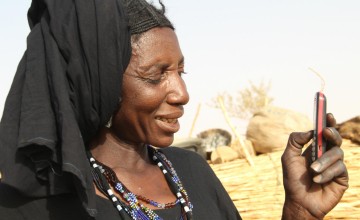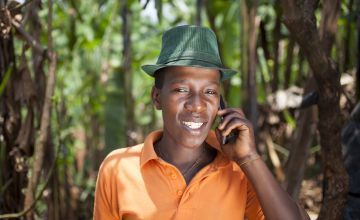
Read our 2024 annual report

Knowledge Hub
Technology solutions for refugees: Bridging the digital divide

Fifteen years ago, in January 2007, the iPhone was officially unveiled to the world. On face value, that may not seem like it has much to do with our work at Concern (and in some ways, the environmental impacts of mobile technology have made our work even harder). However, mobile is one of several technological advancements that have helped us to manage the largest global refugee crisis on record.
For many, especially those of us who grew up with the internet, it’s easy to take this technology for granted: Our employers provide us with laptops.
Our phones tick so many boxes that we barely use them to make calls. Over the last two years, we’ve become even more reliant on devices and internet connections as workplaces, schools, and social lives have moved online.
But a global Digital Divide persists, broadening an inequality gap for people, especially those in low-income countries and vulnerable communities.
This doesn’t have to be the case. In fact, technology is at its best when it’s being used to help close up inequity gaps. It’s not a magic solution for all of the challenges refugees face, but here are six ways technology has proven its worth.
1. Financial inclusion for refugees
In a humanitarian crisis, cash is one of the most sought-after resources, especially for refugees who often abandon their livelihoods when they leave home and face barriers to employment in their host communities — including legal restrictions and language barriers.
Cash transfers give refugees the financial stability they need to live in displacement, as well as autonomy to decide what is most important for them and their family (versus, say, receiving a food basket or shelter kit).
Cash transfers have been made even easier to complete and scale up thanks to mobile transfers. In a matter of seconds, vital funds can be distributed to thousands of people, via a secure platform and with an accredited financial institution.
This has been especially vital in the last two years, as mobile transfers can be made with minimal face-to-face interaction.
2. Employment opportunities and trainings
In many cases, there are opportunities for refugees to find work, either with the skills they already have, or by developing new skills that can be put to use within their host communities.
Organisations like Refugee Talent are dedicated to matching qualified candidates with the right job. In 2017, the e-learning platform Coursera partnered with UNHCR to launch the special platform Coursera for Refugees.
Livelihoods for refugees is a big aspect of Concern’s work as well.
For example, Lebanon hosts the highest number of refugees per capita, mostly from neighbouring Syria.
Building Resilient Communities in Lebanon, a three-year project run between 2017 and 2020, was designed to respond to the economic strain felt in both host and refugee communities.
Concern worked with several Alliance2015 partners to provide training in five key sectors, including information technology (IT). Some participants were placed in apprenticeship programmes to receive on-the-job training, and the initiative also provided individual job-matching services.
3. Supporting teachers in refugee communities
“Teachers for Teachers” is an initiative co-led by the UNHCR and Teachers College at Columbia University that has used mobile technology to strengthen the training and support systems for teachers in Kenya’s Kakuma Refugee Camp.
Educators in the community receive face-to-face training, followed by mobile mentoring and coaching, a combination that allows participants to enjoy sustained support throughout the year, including resources, tips, and inspirational thoughts to navigate the complex context of uncertainty within a refugee camp.
Initial findings have shown that this model has increased teachers’ confidence and capacity in areas like managing their classrooms and positive discipline techniques.

4. Ensuring children have their basic right to an education
Technology can also help refugee children keep up with their education - an essential and fundamental human right.
In 2017, six years into the Syrian conflict, Concern received a grant of nearly €300,000 from Google for the Learning Tech for Refugees Project.
The project was designed to meet the educational needs of Syrian refugee children and provided nearly 1,200 laptops and tablet devices. These devices were loaded with educational software to teach subjects like Arabic.
Concern partnered with the Irish Refugee Council for this project, which also distributed tech bundles to refugee children living in Ireland for the same purposes of continuing education.
Corporate partner Accenture also offered to provide a range of online training in digital, language, and workplace skills. It was also one of several initiatives funded by the NetHope Device Challenge which, in just over five years, closed the digital divide for tens of thousands of refugees around the world.
5. Nimble solutions to pandemic-sized challenges
When social distancing efforts were first introduced in Turkey in March of 2020, programs for Syrian refugees in the country, such as Caregiver Engagement training, were threatened with a potential standstill.
Mobile technology, however, kept these projects running while keeping families safely distanced. Parents and caregivers met in virtual groups, with sessions and support delivered via phone and WhatsApp.
Since lockdown also added stress to small living spaces and large families with young children, participants also received weekly activity ideas for their families, tailored to the ages of their children and designed to be done with whatever materials they may have in the home.
They could also send in photos or videos of their children participating in the activities for feedback and support from Concern’s facilitators.
“I thought the communication by phone was a good thing,” said mum-of-seven Khadija* last year. “I didn’t have to go far [to attend the trainings], and the rest of the family could attend the sessions with me.” Khadija took advantage of the home-learning environment and involved her husband and children in the sessions.
6. Information by and for refugees
The bad news when it comes to the internet is that anyone can publish anything on it. The good news about the internet is… that anyone can publish anything on it. Websites like UNHCR Ireland provide resources that help refugees understand their rights in a given community and handle other logistics of displacement.
Websites like Concern Worldwide also help to educate non-refugees about the current crisis and correct fake news.
But by far the most valuable aspect of the internet in terms of storytelling, especially since the advent of social media, is that more refugees than ever are now able to share their own stories on their own terms.
Hassan Akkad, a Syrian filmmaker and activist who has lived the last 10 years as a refugee in the United Kingdom, has built an Instagram audience of over 25,000 people — and more than double that on Twitter — and is now the author of the memoir Hope Not Fear. Similarly, 22-year-old Syrian Maya Ghazal documents her life, including her work as a pilot and engineer, on Instagram.
In a recent post, she writes: “I know first hand what it means to be a refugee. I know that we are not numbers, but individuals with hopes and dreams, who have left everything behind to find safety, and who also have a lot to give.”

Improved reporting that leads to better programs and solutions over time
Simply put, technology allows us to be better at our jobs. Concern has been using Digital Data Gathering to monitor our projects around the world for the last 10 years, beginning with a conservation agriculture project in Malawi.
The digital process reduced the risk of entering data incorrectly, misinterpretation, incompletion, and the loss of data in the field. It also increased the efficiency of the collection process and significantly reduced the time between data gathering and analysis.
Since then, we’ve used the technology available to us — and many of the people we serve — to improve the efficacy of our work, and the accuracy of our reports.


